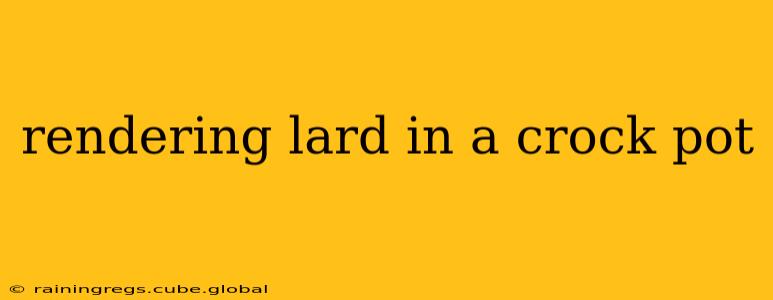Rendering lard in a crock-pot is a surprisingly simple process that yields a pure, flavorful lard perfect for baking, frying, and more. This method offers a hands-off approach compared to stovetop rendering, allowing you to focus on other tasks while the magic happens. This guide will walk you through each step, answering common questions along the way.
What is Lard Rendering?
Lard rendering is the process of separating the fat from the connective tissues and other impurities in raw pig fat. The result is pure, clarified lard—a fantastic cooking fat prized for its flavor and high smoke point. Using a crock-pot simplifies this traditionally time-consuming task.
What Cut of Pork Fat Do I Need for Lard Rendering?
The best cuts for lard rendering are those with a high fat content and minimal lean meat. Leaf lard, the fat found around the kidneys and loins, is the most desirable due to its delicate flavor and high-quality rendering. However, you can also successfully render lard from other fatty cuts, such as back fat. Just be sure to trim away any excess skin or lean meat.
How Long Does it Take to Render Lard in a Crock-Pot?
Rendering time in a crock-pot varies depending on the amount of fat and your crock-pot's settings. Generally, you can expect the process to take 8-12 hours on low or 4-6 hours on high. The key is to cook the fat slowly and gently to avoid burning it. You'll know it's done when the fat is clear and the cracklings (crispy bits) are golden brown and brittle.
Can I Use a Slow Cooker Liner?
Yes, using a slow cooker liner can make cleanup significantly easier. The liner catches most of the rendered fat and cracklings, making it easier to discard the solids and clean the pot afterwards. However, ensure your liner is suitable for high temperatures and fats.
How Do I Strain the Rendered Lard?
Once the lard is rendered, you'll need to strain it to remove the cracklings. Line a fine-mesh sieve or cheesecloth over a bowl and carefully pour the hot mixture through. Press gently on the cracklings to extract as much lard as possible. Allow the lard to cool and solidify completely before storing.
What is the Best Way to Store Rendered Lard?
Proper storage is crucial to maintain the quality and shelf life of your rendered lard. Store the solidified lard in airtight containers in a cool, dark place. It can be stored at room temperature for several months or in the refrigerator for up to a year. Freezing is also an option for longer-term storage.
Can I Use Rendered Lard for Baking?
Absolutely! Rendered lard is a fantastic baking fat. It produces flaky, tender pastries and adds a rich flavor to cakes and cookies. It's often preferred over vegetable shortening for its superior flavor and texture.
What are the Benefits of Making Homemade Lard?
Making your own lard allows you to control the quality and source of your ingredients. You know exactly what's going into your food, avoiding potential additives or preservatives found in commercially produced fats. Plus, homemade lard typically has a superior flavor and texture.
What Should I Do With the Cracklings?
Don't throw away the cracklings! They're incredibly tasty and versatile. You can use them as a crispy topping for salads, soups, or chili, or grind them into a flavorful powder to season dishes.
Rendering lard in a crock-pot is a rewarding process that results in a high-quality, flavorful fat. By following these steps and tips, you can easily create your own supply of homemade lard, perfect for enhancing your culinary creations. Remember to always prioritize safety when handling hot fat.
